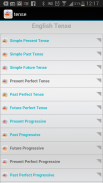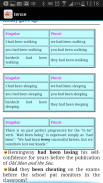




English Tense

Deskripsi English Tense
Tense shows the time of a verb's action or being. There are three inflected forms reflected by changes in the endings of verbs. The present tense indicates that something is happening or being now: "She is a student. She drives a new car." The simple past tense indicates that something happened in the past: "She was a student. She drove a new car." And the past participle form is combined with auxiliary verbs to indicate that something happened in the past prior to another action: "She has been a student. She had driven a new car."
Unlike most other languages, English does not have inflected forms for the future tense. Instead, English future forms are created with the use of auxiliaries: "She will be a student. She is going to drive a new car." English can even create the future by using the present tense, "The bus arrives later this afternoon," or the present progressive, "He is relocating to Portland later next month."
Tense menunjukkan waktu tindakan verba atau sedang. Ada tiga bentuk infleksi tercermin perubahan di ujung kata kerja. Present tense menunjukkan bahwa sesuatu sedang terjadi atau menjadi sekarang: "Dia adalah seorang mahasiswa Dia mengendarai mobil baru.." Sederhana lampau menunjukkan bahwa sesuatu terjadi di masa lalu: ".. Dia adalah mahasiswa Dia mengendarai mobil baru" Dan bentuk past participle dikombinasikan dengan kata kerja bantu untuk menunjukkan sesuatu yang terjadi di masa lalu sebelum tindakan lain: ".. Ia telah menjadi mahasiswa Ia telah didorong mobil baru"
Tidak seperti kebanyakan bahasa lain, bahasa Inggris tidak memiliki infleksi bentuk untuk future tense. Sebaliknya, bentuk masa depan Inggris yang dibuat dengan menggunakan pembantu: ". Dia akan menjadi siswa Dia akan mengendarai mobil baru." Inggris bahkan dapat menciptakan masa depan dengan menggunakan present tense, "tiba bus sore ini," atau progresif ini, "Dia pindah ke Portland pada akhir bulan depan."
Tense shows the time of a verb's action or being. There are three inflected forms reflected by changes in the endings of verbs. The present tense indicates that something is happening or being now: "She is a student. She drives a new car." The simple past tense indicates that something happened in the past: "She was a student. She drove a new car." And the past participle form is combined with auxiliary verbs to indicate that something happened in the past prior to another action: "She has been a student. She had driven a new car."
Unlike most other languages, English does not have inflected forms for the future tense. Instead, English future forms are created with the use of auxiliaries: "She will be a student. She is going to drive a new car." English can even create the future by using the present tense, "The bus arrives later this afternoon," or the present progressive, "He is relocating to Portland later next month."


























